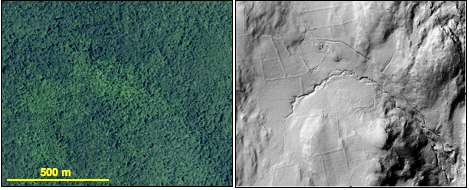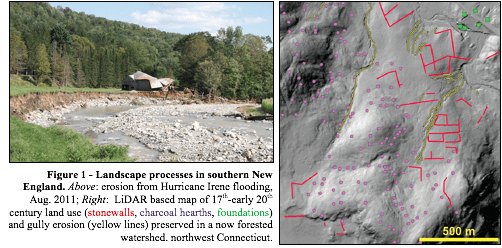What: The 2015 southern New England Keck project will investigate Holocene and Anthropocene sediments and landforms to understand the regional history of floods, climate change and human impact. We will focus on targeted long-timescale (Holocene) sediment archives within major watersheds in the region (Housatonic, Connecticut, Thames) as well as detailed studies in small basins where multiple types of intense 17-early 20th land use and gully erosion has been identified. We will take advantage of the close proximity of focus areas and the home institution of the project leaders, allowing for a mix of field and laboratory research by student participants and active engagement with thriving research communities.
When: June 29 – July 23, 2015
Where: Southern New England (northwestern Connecticut and western Massachusetts). Students will be housed at UConn and we will make day and overnight trips to the field. Students will have access to laboratory facilities at UConn.
Who: Six students. UConn Project leaders William Ouimet (geomorphology) and Michael Hren (geochemistry), and UConn graduate assistants.
Project Overview, Goals and Methods: The primary goal of the 2015 southern New England Keck project is to provide a unique and innovative research experience that integrates the diverse expertise of the project leaders to develop sedimentary and geochemical records of climate, landscape change, and human impact from the Holocene through the Anthropocene. Specific project goals include making field measurements and collecting cores/samples to help characterize the: (1) sedimentary archives and records of Holocene and Anthropocene environmental change; and (2) extent, impact and legacy of intense human modification to this landscape in the 18th to early 20th century. Broad research questions include:
- What is the record of Holocene floods in southern New England, providing a Holocene context for events such as Hurricane Irene in 2011?
- How do records of Holocene climate change vary across the region?
- Is there a record of frequent fire in northeastern forests over the Holocene?
- What is the erosional and depositional legacy of historic land use and sediment mobilization?
- How does landscape response to widespread deforestation in de-glaciated regions such as southern New England compare to well-studied examples in un-glaciated landscapes in the mid-Atlantic US?
- What is the role of slope and surface geology in affecting land use and degree of landscape response?
- What is the legacy of historic land use on soil morphology, carbon storage and geochemistry in now reforested terrain?
To answer these questions we will employ the following GIS, field and laboratory methods:
- LiDAR based mapping, spatial analysis, field calibration and site selection
- Field mapping of landforms, and surveying
- Collection of sediment cores in wetlands, kettle ponds adjacent to river courses, and mill dams
- Trenching, soils description and collection of soil samples
- Sedimentological analysis of all sediment samples (grain size analysis, LOI)
- Organic geochemistry of select sediment cores (C and H isotopes of plant waxes in soils and sediments; C/N isotopes in organic matter; H isotopes; Polycyclic aromatic hydrocarbons – PAHs)
- Tree surveying (for biomass calculations) and tree coring (dendrochronology and tree ring isotope analysis)
- ICP analysis of major and trace cations and metals (e.g., Hg) in sediments
- Sample collection and prep associated with 137Cs, 210Pb and 14C dating
Geologic Background: The processes that shape the southern New England landscape have shifted dramatically from Pleistocene glaciation to Holocene transgression to Anthropocene land management. The landscape of southern New England preserves a diverse record of Late Pleistocene to present environmental change. The Laurentide Ice Sheet retreated from the region between 21 and 17 ka, leaving a diverse array of glacial landforms and sediments throughout the landscape and leading to complex grain size variations throughout watersheds, river fragmentation (including wetlands), and varied bedrock/alluvial rivers (Thorson et al., 1998; Stone et al., 2005). More recently, the landscape experienced a remarkable history of land-use/land-cover change where nearly 200 years of deforestation and agricultural expansion in the 17th to early 20th centuries was followed by a dramatic reduction in agriculture and forest regrowth (Cronon, 1983; Merchant 1989; Foster et al., 2008) (Figure 1). In addition to landscape response associated with deglaciation and human impact, the southern New England landscape has also seen a range of climatic variability and extreme events such as hurricanes, floods and large-scale fires over the Holocene (e.g., Patton, 1988).

Figure 1. Overview map of the 2015 southern New England Keck project
study area (image credit: USGS Connecticut River Watershed Atlas)
The 2015 southern New England Keck project will focus on select sediment archives within major watersheds in the region (Housatonic, Connecticut, Thames – Fig. 2) as well as detailed studies in small basins where multiple types of intense 17-early 20th land use and gully erosion has been identified (Figure 3). New geospatial data (LiDAR) has opened our eyes to a new level of detail for the geomorphology and dynamic history of this region. Available LiDAR datasets cover vast stretches of the forested terrain that now dominates the region and allow for a high resolution view of landforms and processes, fine scale targeting of field sites, and direct mapping of small scale features associated with the region’s 17th to early 20th century land use history (Johnson and Ouimet, 2014) (Figure 1 & 3). The 2015 southern New England Keck project will utilize LiDAR to target field sites for coring and trenching such as kettle ponds, wetlands and mill ponds, as well as identify watersheds characterized by varying types and extent of historic modification.
Potential Student Projects: Students and project faculty will collect data and samples at field sites. We will work on laboratory preparation and initial sample treatment at the University of Connecticut. We expect that participants will return to their home institution with field data, initial results of some laboratory measurements and samples ready for additional analysis. Analysis and interpretation of field and laboratory results at the home institution will be supervised by the student’s advisor and aided by the Project Director. Potential student projects and details include:
- Evaluating the record of sedimentation and environmental change within sediment traps along major waterways. LiDAR analysis reveals many potential sites for sediment coring and detailed geospatial analysis within the Housatonic, Connecticut and Thames River watersheds (Figure 4), including one where preliminary data indicates preservation of 4 major floods over the last 11,000 yrs. Projects focused on these cores will include obtaining and analyzing Holocene paleo-climate records (employing organic geochemistry) and reconstructing evidence for historic flooding (employing sedimentalogical analysis and DEM based flood modeling).
- Evaluating the record of sedimentation and environmental change within wetlands lying within low-gradient portions of the landscape and near topography displaying evidence for widespread historic land use. Projects would be focused on obtaining paleo-climate records as well as trying to identify and analyze legacy sediment hypothesized from 17th-early 20th century deforestation, erosion and sediment mobilization. We plan to target wetlands in the region allowing for a comparison with depositional records from steep portions of the landscape (i.e., eastern vs. northwest CT).
- Evaluating the record of sedimentation behind numerous historic mill-dams that have been identified through LiDAR and field work. Projects would be focused on identifying, characterizing and analyzing the sedimentological and geochemical signature of legacy sediment hypothesized from 17th-early 20th century deforestation, erosion and sediment mobilization.
- Evaluating widespread gully erosion observed throughout the region. Projects would be focused on addressing the hypothesis that gully erosion is dominantly Holocene or Anthropocene in origin.
- Field analysis and GIS based mapping of terraces and alluvial fans within historically impacted, but now reforested watersheds. Projects would be focused on identifying and analyzing these landforms and sediment deposition associated with 17th-early 20th century deforestation, erosion and sediment mobilization.
- Characterizing soil morphology and geochemistry for hillslope locations defined by different age, extent and types of historic land use. From historical imagery and LiDAR, we can specifically target hillslope locations characterized by different types and hypothesized periods of abandonment and land use.
- Evaluate whether there is a record of forest fire in northeastern forests over the Holocene. Projects would be focused on the measurement of PAHs in various sediment archives collected by the research group. Fire is hypothesized to have occurred in dry periods during the Holocene, as well as in association with Native American land use practices prior to European settlement.

Figure 3: An aerial image shows a forested landscape while a hillshaded DEM derived from LiDAR data for the same area reveals polygons of stone wall lined fields, an old road, circular charcoal hearth platforms (lower right), an old foundation, and gully erosion. Data sources: CTECO (imagery) and USDA NRCS (LiDAR).
Working Conditions: Fieldwork will include walking in forests and along streams in heavily wooded areas and coring in muddy environments and occasionally using small boats. All students are required to be proficient swimmers. Insect repellent is required as some ticks in the area carry Lyme Disease. Only faculty and UConn graduate students will drive the vehicles.
Logistics: Keck 2015 project participants will be housed in dormitories and will eat breakfast and dinner at the University of Connecticut. We will make day trips to the field. Lunches will be provided on field days. There will be a longer trip in the beginning where we will camp and conduct fieldwork from a base camp. In addition, students will have access to laboratory facilities at UConn.
Recommended Courses/Prerequisites: Important for this interdisciplinary project is a strong interest in surface and near-surface processes and in interdisciplinary science, a record of hard work and the ability to follow through. We prefer gregarious, “can-do” students with a background in geology or physical geography and coursework in:
- Geomorphology/Quaternary geology or hydrology
- Earth materials and/or geochemistry
- Sedimentology and/or soils
- GIS or a strong background in supporting science
Contact Information
William Ouimet (william.ouimet@uconn.edu), phone: 860-486-3322

